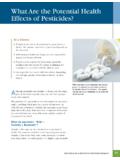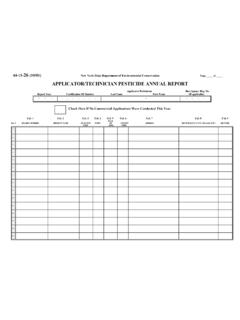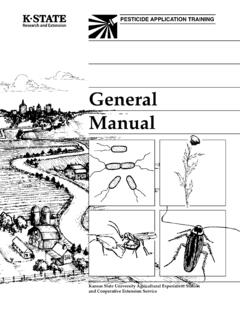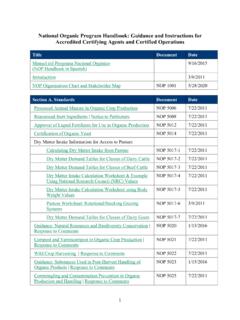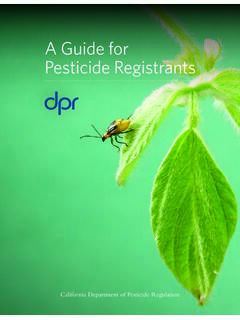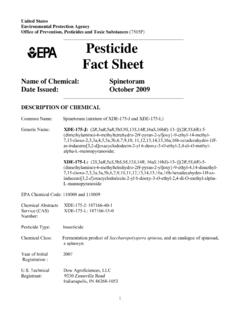Transcription of United States Environmental Protection Agency Office of ...
1 1 United States Environmental Protection Agency Office of Prevention, pesticides and Toxic Substances (7505P) _____ Pesticide Fact Sheet Name of Chemical: Chlorantraniliprole Reason for Issuance: Unconditional Registration Date Issued: April 2008 _____ TABLE OF CONTENTS 1. Description of the 2. Use patterns and 3. Science 4. Human Health Exposure 5. Environmental Exposure and 6. Regulatory Position and 7. Reduced Risk 8. Contact 9. Appendix I: Glossary of Terms and 10. Appendix II: 1. DESCRIPTION OF CHEMICAL Chemical Name: 3-Bromo-N-[4-chloro-2-methyl-6-(methylca rbamoyl)phenyl]-1-(3-chloro-2-pyridine-2 -yl)-1H-pyrazole-5-carboxamide Empirical Formula C18H14N5O2 BrCl2 Common Name: Chlorantraniliprole Experimental Name: DPX-E2Y45 EPA PC Code: 090100 2 Chemical Class: Anthranilic diamide insecticide Mode of Action: Interruption of normal muscle contraction Pesticide Type: Insecticide Technical Registrant.
2 DuPont Crop Protection Box 30 Newark, DE 19714-0030 Chemical Structure: NNNNHOClBrNHOCl 2. USE PATTERNS AND FORMULATIONS Registered Uses: pome fruit (crop group 11), stone fruit (crop group 12), leafy vegetables (crop group 4), Brassica leafy vegetables (crop group 5), cucurbit vegetables (crop group 9), fruiting vegetables (crop group 8), cotton, grapes, potatoes, rice, and ornamentals and turf grass growing in residential, commercial, and public landscaped areas Pests/Application Sites: moths, beetles, caterpillars, etc. Application Rates: Seasonal Maximum: Food Crops- lb (rice- ) Turf Grass- lb Ornamentals- highly variable, range between to lb Types of Formulations/ Product Names: Technical.
3 DuPont Rynaxypyr Technical ( ) End Use (Agricultural Uses): DuPont Coragen ( ; suspension concentrate) 3 DuPont Altacor (35% ; water dispersible granule) End Use (Turf and Ornamental Uses): DuPont E2Y45 SC Insecticide ( ; suspension concentrate) DuPont E2Y45 Insecticide ( ; granular) DuPont E2Y45 Insecticide ( ; granular) DuPont E2Y45 Insecticide + Fertilizer ( ; granular) Manufacturing Concentrate (35% ) 3.
4 SCIENCE FINDINGS Physical and Chemical Characteristics: Available product chemistry data supporting the use of chlorantraniliprole are summarized below in Tables 1 and Table 1. Chlorantraniliprole Nomenclature. Chemical structure NNNNHOClBrNHOCl Common name Chlorantraniliprole Company experimental name DPX-E2Y45 IUPAC name 3-Bromo-N-[4-chloro-2-methyl-6-(methylca rbamoyl)phenyl]-1-(3-chloro-2- pyridine-2-yl)-1H-pyrazole-5-carboxamide CAS name 3-Bromo-N-[4-chloro-2-methyl-6-[(methyla mino)carbonyl]phenyl]-1-(3-chloro-2-pyri dinyl)-1H-pyrazole-5-carboxamide CAS registry number 500008-45-7 Table Physiochemical Properties of the Technical Grade Test Compound Parameter Value Melting point/range ( C) 200-202 ( )/208 210 ( ) pH at 20 C Relative Density ( ) ( ) at 20 C 4 Table Physiochemical Properties of the Technical Grade Test Compound Parameter Value Water solubility (20 C) Deionized Water mg/L pH 4 mg/L pH 7 mg/L pH 9 mg/L Solvent solubility (20 C)
5 Acetone g/L Acetonitrile g/L Ethyl Acetate g/L Dichloromethane g/L Dimethylformamide 124 4 g/L n-Octanol g/L Methanol g/L n-Hexane < g/L o-Xylene g/L Vapor pressure x 10-12 Pa @ 20 C, x 10-11 Pa @ 25 C Dissociation constant, pKa Octanol/water partition coefficient, KOW (20 C) Deionized Water 589 pH 4 588 pH 7 721 pH 9 654 UV/visible absorption (max) pH <2 no absorption max >200 nm, at 290 = 3941 pH 7 no absorption max >200 nm, at 290 = 4185 pH >10 absorption max at ~320 nm which may be due to decomposition of DPX-E2Y45, at 290 = 6082 Metabolism Assessment: The nature of the residue in plants and livestock is adequately understood.
6 Very little degradation was observed in primary and rotational crops. Unchanged parent chlorantraniliprole was the major identified residue in primary and rotational crops. The metabolism of chlorantraniliprole in livestock was extensive and followed the major steps similar to those observed in rice: (i) hydroxylation of the N-methyl group (to IN-H2H20) or hydroxylation of the tolyl methyl group (to IN-HXH44); (ii) cyclization with loss of water to a quinazolinone derivative (IN-EQW78); and (iii) N-demethylation via IN-H2H20 to IN-F9N04. Hazard Characterization: Toxicology Requirements- The toxicology requirements (40 CFR ) for a food use for chlorantraniliprole are in Table 2. 5 Table 2. Toxicology Data Requirements Technical Test Required Satisfied Acute Oral Acute Dermal Toxicity .. Acute Inhalation Primary Eye Primary Dermal Irritation .. Dermal Sensitization .. yes yes yes yes yes yes yes yes yes yes yes yes Oral Subchronic (rodent).
7 Oral Subchronic (nonrodent) .. 21-Day Dermal .. 90-Day Dermal .. 90-Day yes yes yes no no yes yes yes - - Developmental Toxicity (rodent).. Developmental Toxicity (nonrodent) .. Reproduction .. yes yes yes yes yes yes Chronic Toxicity (rodent) .. Chronic Toxicity (nonrodent).. Oncogenicity (rat).. Oncogenicity (mouse) .. yes yes yes yes yes yes yes yes yes yes Mutagenicity Gene Mutation - Mutagenicity Gene Mutation - Mutagenicity Structural Chromosomal Mutagenicity yes yes yes yes yes yes yes yes Acute Delayed Neurotox. (hen) .. 90-Day Neurotoxicity (hen) .. Acute Neurotox. Screening Battery (rat) .. 90-Day Neuro. Screening Battery (rat).. Develop. Neuro .. no no yes yes no - - yes yes - General Metabolism .. Dermal yes no yes - Special Studies 28-day immunotoxicity (rat) .. 28-day immunotoxicity (mouse).. yes yes Acute Toxicity- Chlorantraniliprole Technical is toxicity category IV for all routes of exposure and is a non-sensitizer (Table 3).
8 Table 3. Acute Toxicity of Technical Chlorantraniliprole Guideline No. Study Type MRID No. Results Toxicity Category Acute oral toxicity 46889112 LD50 = >5000 mg/kg bw IV Acute dermal toxicity 46889113 LD50 = >5000 mg/kg bw IV Acute inhalation toxicity 46889121 LC50 = > mg/L IV Acute eye irritation 46889115 Iritis score of 1 in 1/3 rabbits, conjuctival redness score of 1 in 2/3 rabbits. All eyes returned to normal after 72 hours. IV Primary skin irritation 46889114 No dermal irritation, clinical signs or body weight loss IV Dermal sensitization 46889221 Not a dermal sensitizer Negative Subchronic, Chronic and Other Toxicity- In short-term studies, the most consistent effects are those associated with non adverse pharmacological response to the xenobiotic, induction of liver enzymes and subsequent increase in liver weights. Chlorantraniliprole is not genotoxic, neurotoxic, immunotoxic, carcinogenic, or teratogenic. Overall, chlorantraniliprole exhibits minimal mammalian toxicity after long-term exposure.
9 The only consistent observation in the mammalian toxicology studies is an increased degree of microvesiculation of the adrenal cortex after dermal or dietary administration of chlorantraniliprole. Based on the lack of adverse effect on the function of the adrenal gland, this observation was considered treatment related, but not adverse. Table 4. Subchronic, Chronic and Other Toxicity Profile STUDY/ SPECIES DOSES (mg/kg/day) NOAEL (mg/kg/day) LOAEL (mg/kg/day) EFFECTS 14-day Oral Gavage/ rat 0, 25, 100, 1000 1000 Not established No adverse effects. Weak inducer of cytochrome P450 3A at all dose levels, with statistical significance at 100 and 1000 mg/kg/day. 28-Day Oral (feed)/rat 0, , 106 and 584 (male); 0, 24, 128 and 675 (female) 584 (male) and 675 (female) Not established No adverse effects. Slight increase in liver weight at 128 and 675 mg/kg/day in females and minimal hepatocellular hypertrophy at 675 mg/kg that is attributed to enzyme induction characterized by increased amount of eosinophilic cytoplasm with hepatocytes but no histomorphologic evidence of hepatocellular damage.
10 In 128 and 675 mg/kg females, a statistically significant increase in UDP-GT activity was observed in HDT female rats, with a similar increase in males. These changes are consistent with a pharmacological response and were not considered adverse. 28-Day Oral (feed)/mouse 0, 52, 182, 538 and 1443 (male); 0, 64, 206, 658 and 1524 (female) 1443 (male) and 1524 (female) Not established No adverse effects. Slight increase in liver wt. in 658 and 1524 mg/kg/day females corresponded with a mild increase in cytochrome P450 enzyme activity. No histopathological evidence of liver toxicity was observed. A reduction in body weight gain was observed in HDT males (52%) but not in females. No statistically significant decrease in absolute body weight was observed therefore, this effect was not considered adverse. 28-day Oral (capsule)/ Dog 0, 300, 1000 1000 Not established No adverse effects. Induction of cytochrome P450 enzyme activity (58%) in both males and females at 1000 mg/kg/day, specifically 1A1 and 2B1/2 at 300 and 1000 mg/kg/day.










